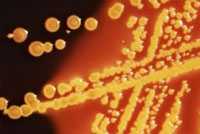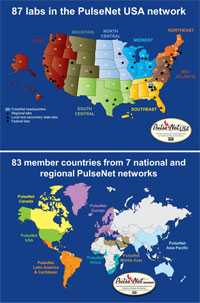PulseNet at Work: Detecting Hazardous Hazelnuts
 They’re usually in bowls of mixed nuts that are a holiday staple. But for 8 people who lived in Michigan, Wisconsin, and Minnesota, the 2010 holidays weren’t so merry. Beginning in late December, they all came down with a rare and serious illness caused by Escherichia coli O157:H7 that was lurking in, of all places, hazelnuts.
They’re usually in bowls of mixed nuts that are a holiday staple. But for 8 people who lived in Michigan, Wisconsin, and Minnesota, the 2010 holidays weren’t so merry. Beginning in late December, they all came down with a rare and serious illness caused by Escherichia coli O157:H7 that was lurking in, of all places, hazelnuts.
Without PulseNet’s ability to match up bacteria from sick people in many locations, this outbreak would not have been caught. PulseNet quickly identified that the type of E. coli stood out from other cases of E. coli infection that were occurring at the same time. The E. coli strain that infected these people had a common DNA pattern or “fingerprint.” After only eight cases of infection, the contaminated food was identified and potential additional illnesses were averted.
So how does PulseNet really work? John Besser, CDC microbiologist, explains, "PulseNet tracks foodborne illness like the FBI tracks criminals. It compares the 'DNA fingerprints' of bacteria from patients to find clusters of disease that might represent unrecognized outbreaks. Health officials can’t stop an outbreak, and industry and regulatory agencies can't make changes to our food and water delivery systems, if they don’t know that outbreaks are occurring. That's where PulseNet comes in. Public health laboratories in all 50 states and food regulatory and agriculture agencies across the United States use PulseNet to track foodborne diseases within their jurisdictions and compare their findings to those from laboratories across the network through a central database at CDC in Atlanta. Because food is truly an international commodity, PulseNet International also has been established in 82 countries around the globe."

Photo of woman examining
DNA readout on a
computer monitor.
In late December 2010, PulseNet quickly detected a suspicious cluster of E. coli O157 infections in the Midwest, and it was then time for local and national investigations. Wisconsin and Minnesota public health departments immediately interviewed anyone who had reported a case of food illness. It turned out that eating hazelnuts was common among people who were sickened by the particular strain of E. coli O157. Hazelnuts were rapidly confirmed by investigators as the cause of the outbreak.
Where did these hazelnuts come from? The Minnesota Department of Agriculture isolated the outbreak strain from leftover hazelnuts from the home of one of the people who got sick. Tests on the hazelnuts recovered in a patient's home identified a E. coli O157:H7 strain that matched patient isolates by DNA analysis. The Food and Drug Administration identified the company distributing the nuts, and the company recalled all of its products in March 2011, containing the outbreak. The results of this investigation, as well as countless others, help industry understand where to focus food safety efforts. In this case, nut producers are able to re-examine the safety of their production practices.

Escherichia coli bacteria grown on agar plate medium
"PulseNet tracks foodborne illness like the FBI tracks criminals."
In less than 3 months, and with only 8 illnesses, the outbreak and food source were identified, the product recalled, and no one died. CDC and its food safety partners also discovered a new food vehicle for E. coli O157:H7 infections—hazelnuts.
E. coli 0157 can make you really sick, causing diarrhea and abdominal cramps, and rarely, even kidney failure. People of any age can become infected. Very young children and the elderly are more likely to develop severe illness, but even healthy older children and young adults can become seriously ill.
For more information about CDC’s food safety work, see:
- Page last reviewed: March 19, 2014
- Page last updated: March 19, 2014
- Content source:


 ShareCompartir
ShareCompartir
